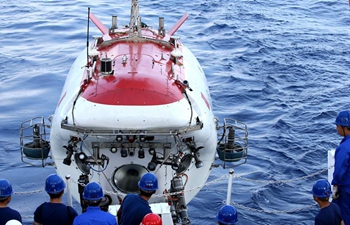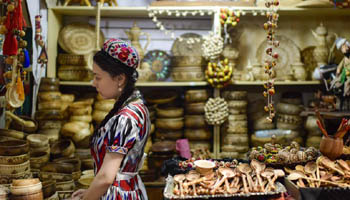SAN FRANCISCO, May 13 (Xinhua) -- A research using time-lapse photography in the Galapagos Marine Reserve, a thousand kilometers from the Ecuadorian mainland, suggests the presence of a key multilevel "trophic cascade" involving top- and mid-level predators as well as urchins and algae.
In the rocky, species-rich subtidal area, of about 133,000 square km off the Galapagos Islands, researchers examined the relationships among predatory fishes, urchins, the algae that the urchins graze on, and how the interactions among them were influenced by se
a lions and sharks at the top of the food chain.
The key question for researchers: Do predators high up in the chain affect the abundance of the "primary producers" at the bottom -- in this case algae -- thus causing a trophic cascade?
Using GoPro cameras, researchers from Oregon State University (OSU) and Brown University made a number of key findings regarding triggerfish, Spanish hogfish, pencil urchins, the larger green urchins and algae, including:
-- Among a diverse guild of predatory fishes, triggerfish can control the abundance of pencil urchins and thus also the abundance of algae the urchins eat; the experiments showed grazing on algae was eliminated when the pencil urchins were exposed to triggerfish predation, meaning triggerfish are a candidate for protection because of their strong effects on ecosystem function.
-- Green urchins eat more algae than pencil urchins yet are not the urchin prey of choice for predatory fish.
That suggests those fish aren' t controlling green urchin populations and thus that green-urchin barrens in the Galapagos - areas where the urchins have stripped the sea floor of algae - are not the result of the overfishing of predatory fish.
-- Spanish hogfish are not major predators of urchins as earlier, survey-based research had suggested.
Hogfish mainly eat the smaller pencil urchins and also interfere with triggerfish feeding on large pencil urchins; the hassling hogfish cause triggerfish to spend more time to eat an urchin and in some cases force a fumble.
Statistical modeling of predation on pencil urchins indicates that two types of interference behavior -- the hogfish harassing the triggerfish, and sea lions and sharks startling the triggerfish -- could slow the rate of triggerfish predation on pencil urchins.
The researcher who did the modeling, Mark Novak of the College of Science at OSU, noted that historically, ecologists believed complex food webs typical of the tropics were more immune to trophic cascades than the simpler food webs of higher latitudes.
However, studies such as this one now suggest that is not the case, and that the dynamics of complex food webs can be as predictable as simpler ones provided you understand who the relevant players are.
"When the backbone of the system is strong, you can connect the top of the food chain to the bottom despite all of the indirect effects and the complexities of the system," Novak, assistant professor of integrative biology, was quoted as saying in a news release.
"It's important to know individual species identity when you've got a suite of consumers. The hogfish, the triggerfish, they all feed on very similar things, yet one of the two is most important, the one that drove that first link."
The findings, published in PLOS One, are important because they include detailed information about interactions in a complex food web, and crucial to knowing how to cause, prevent or reverse population changes within the web.

















